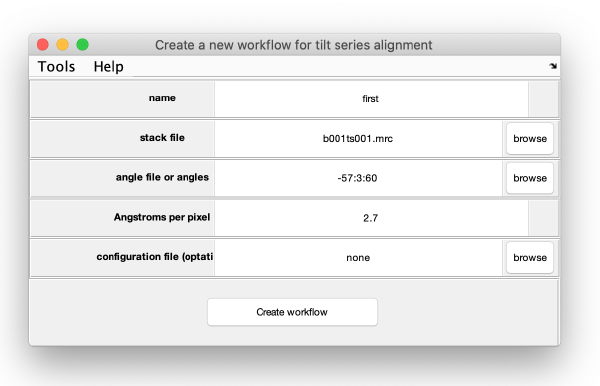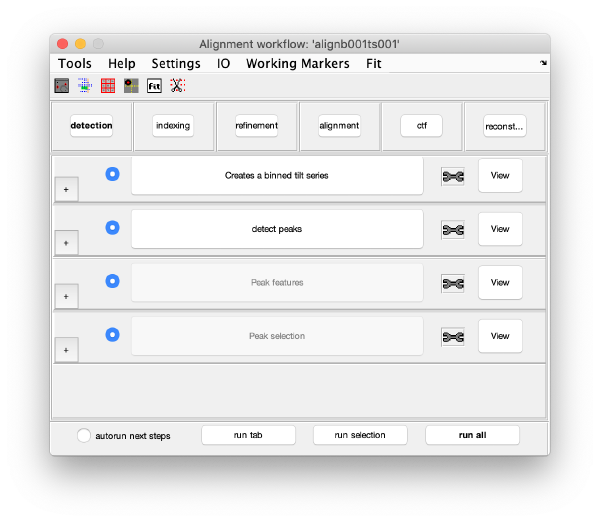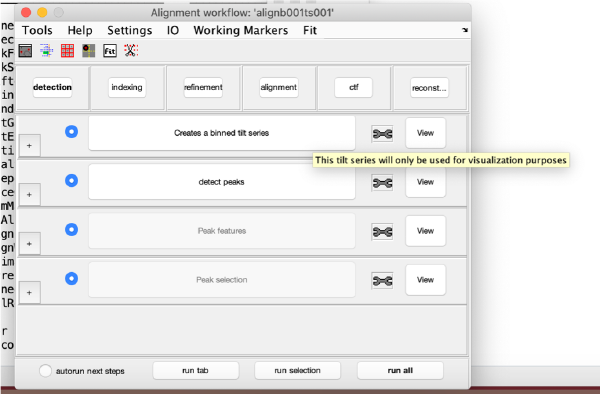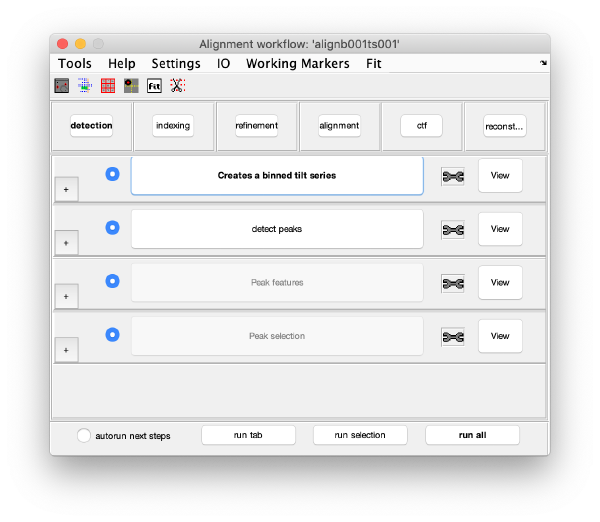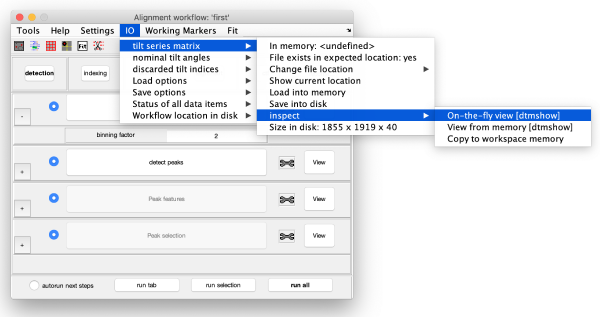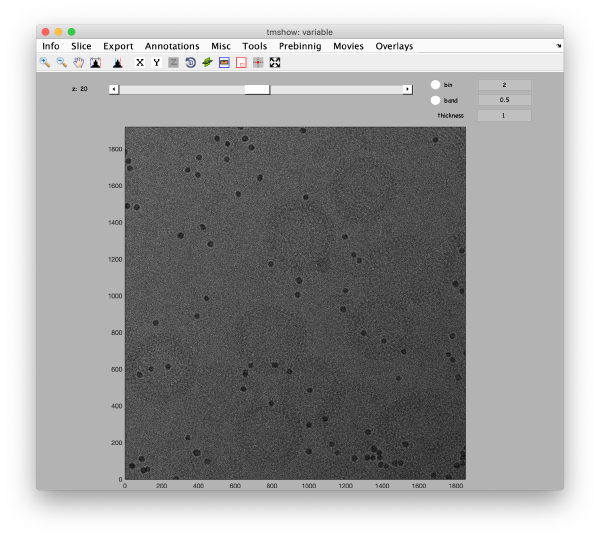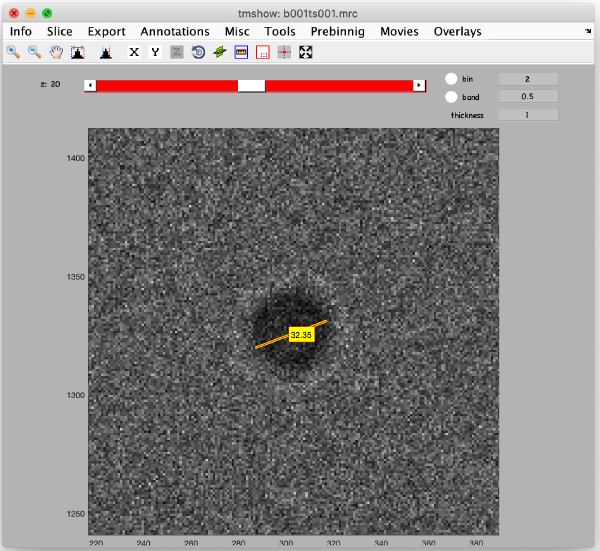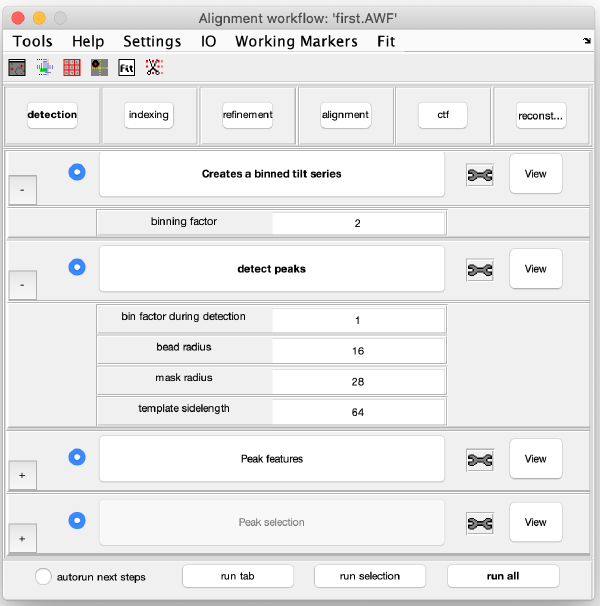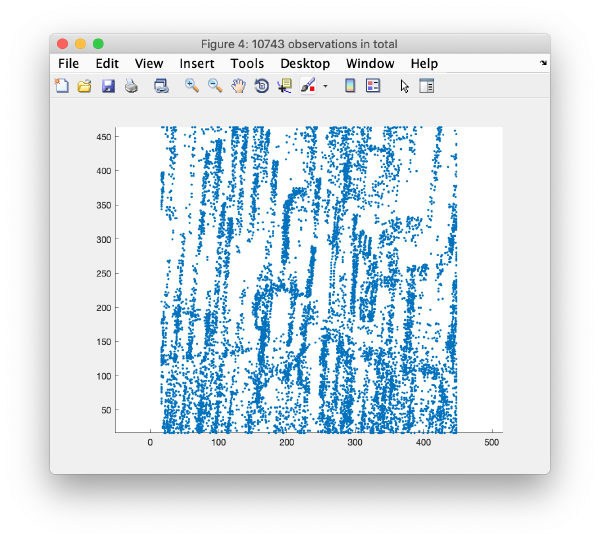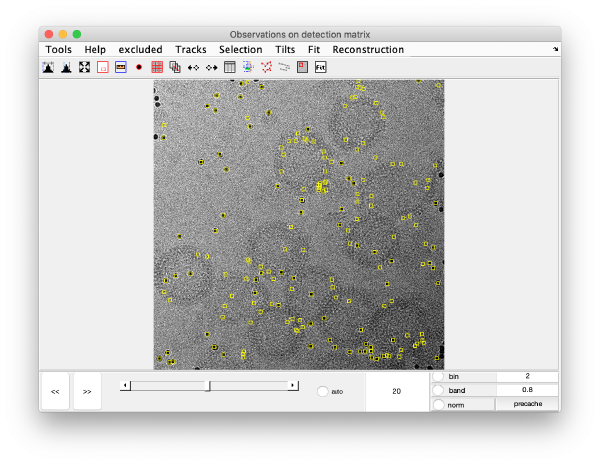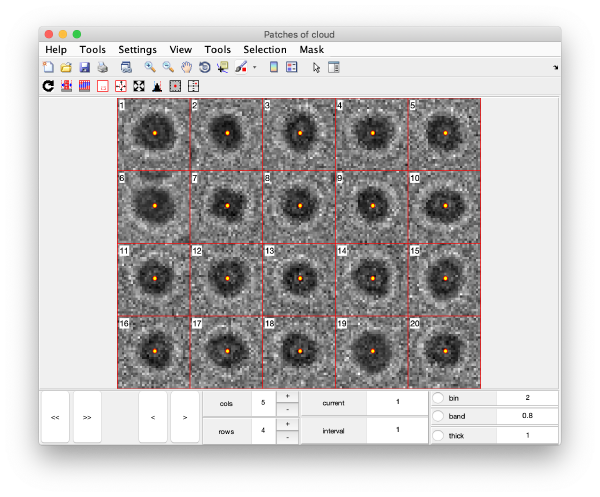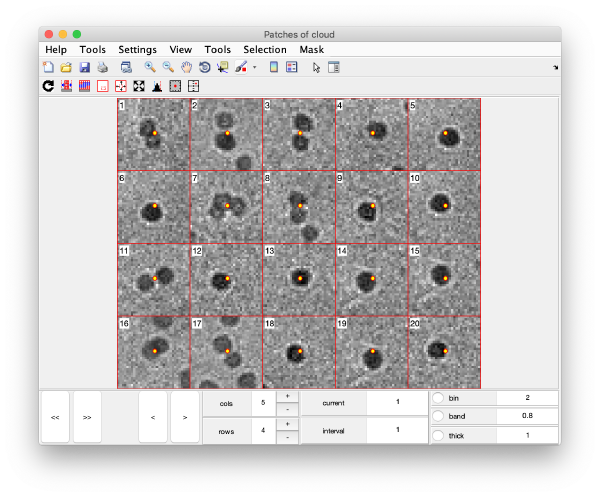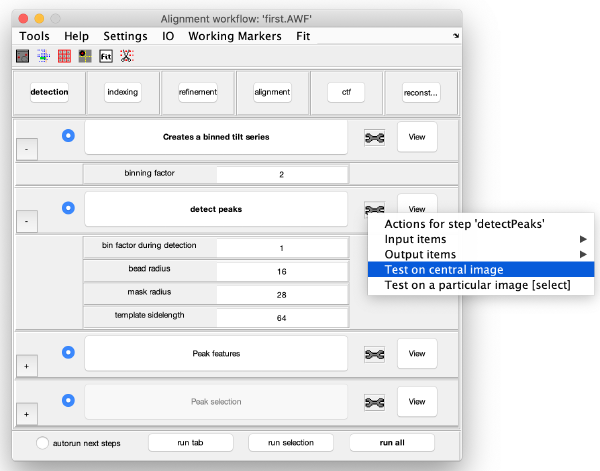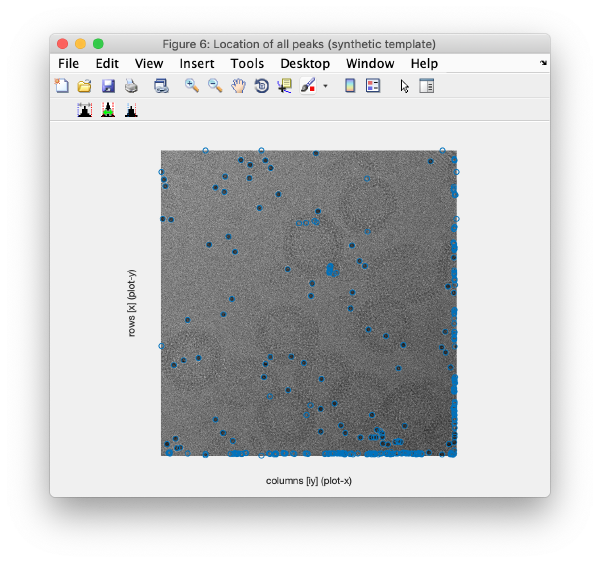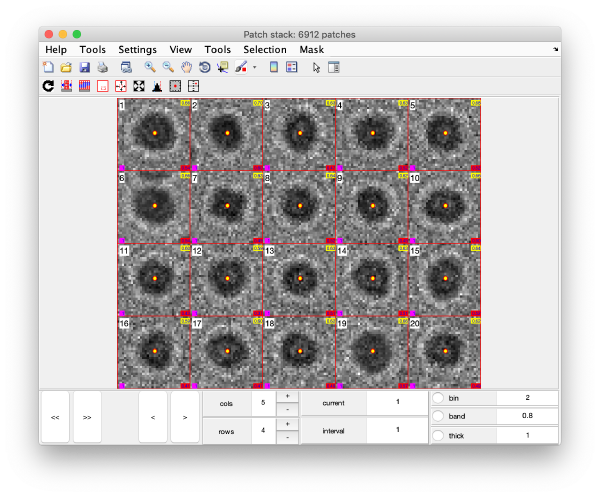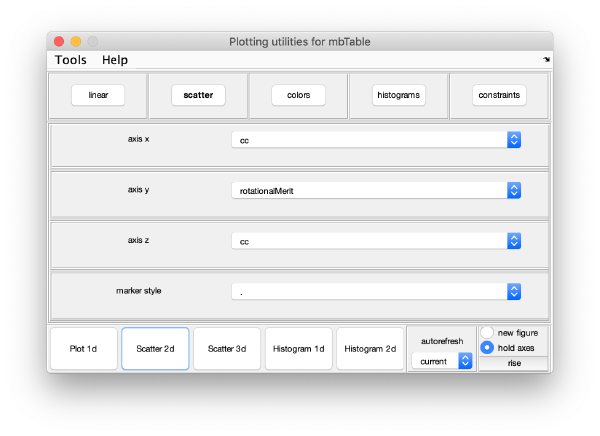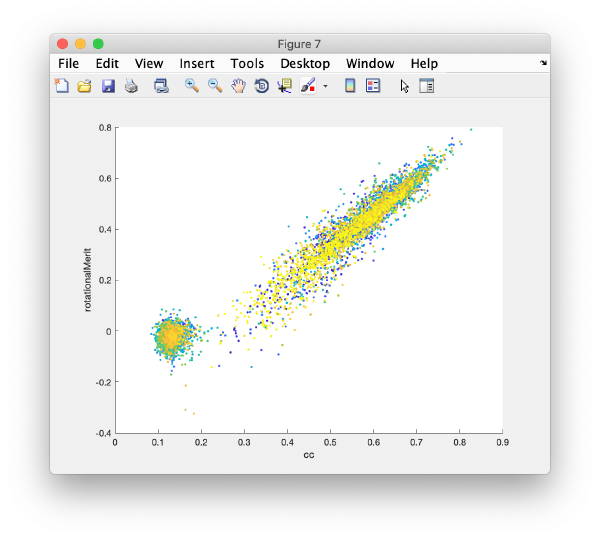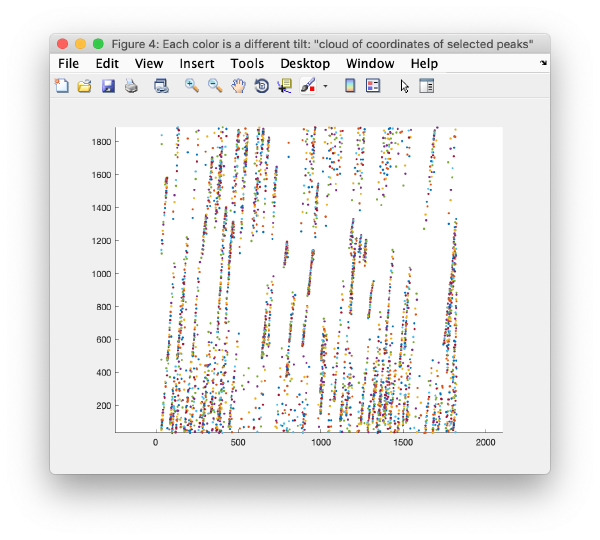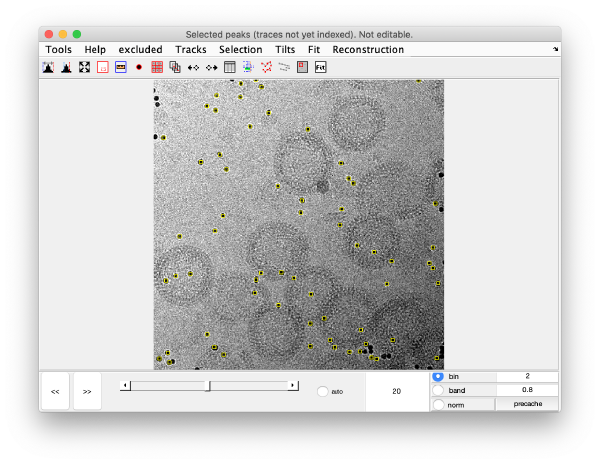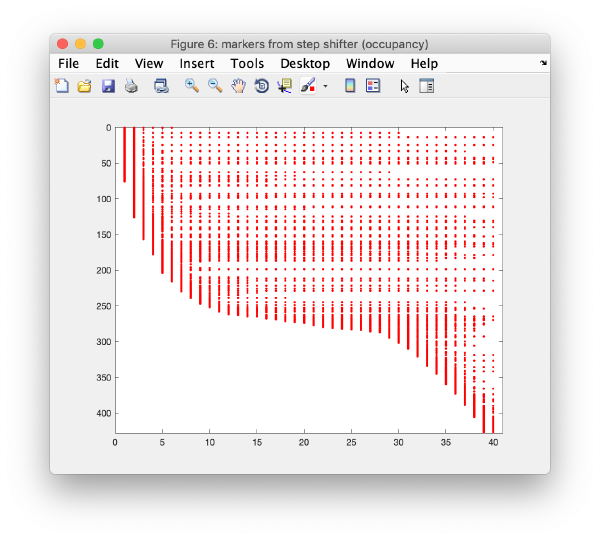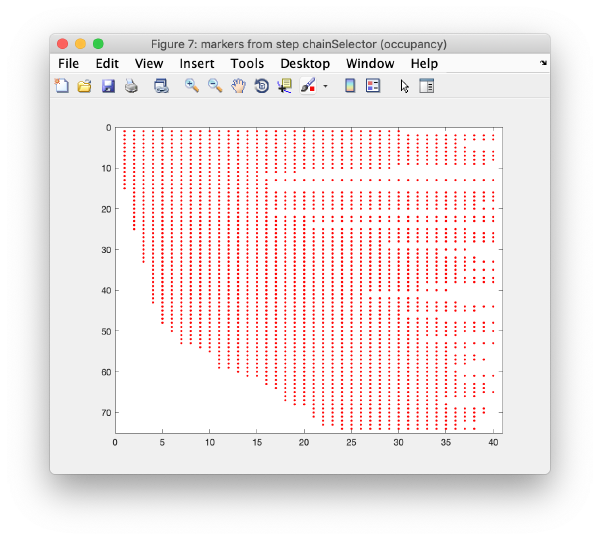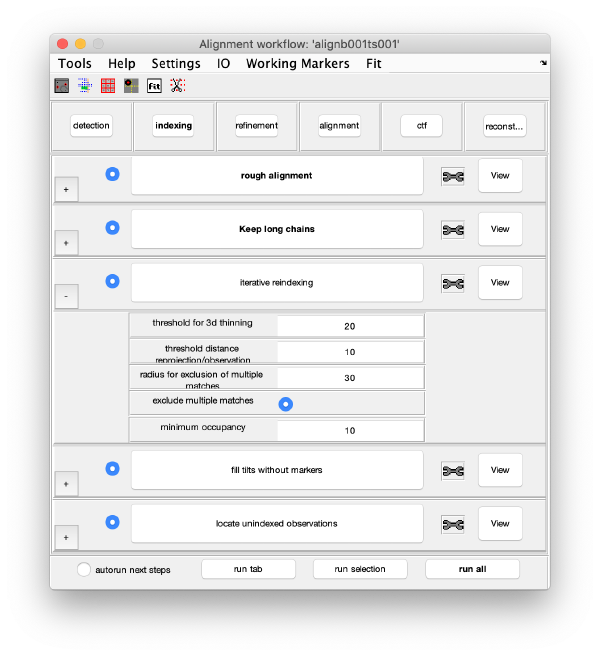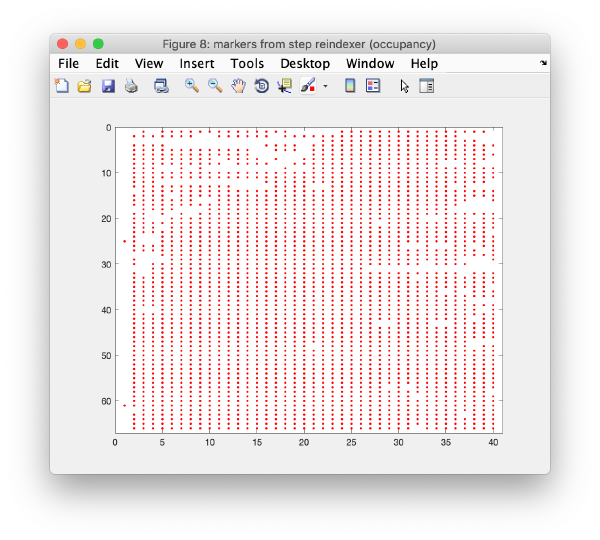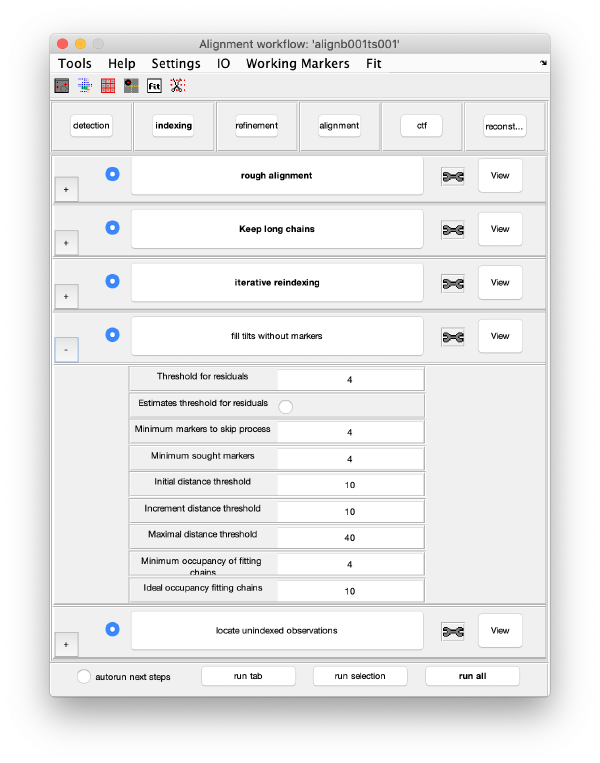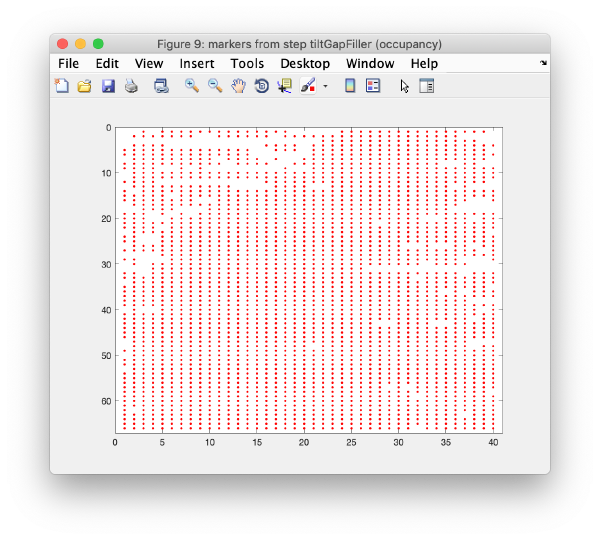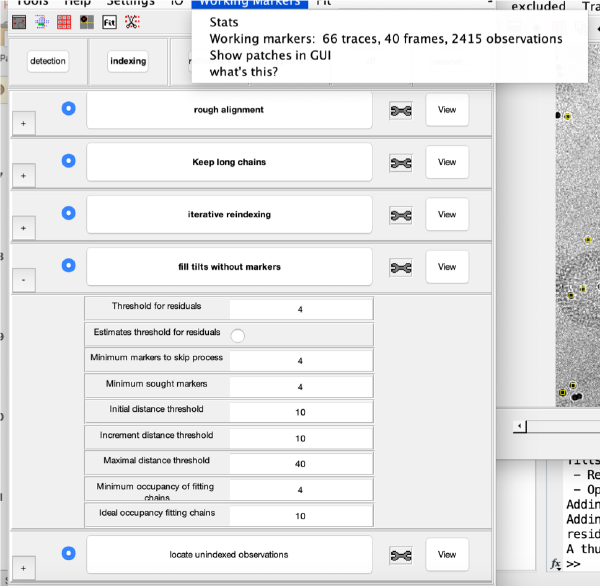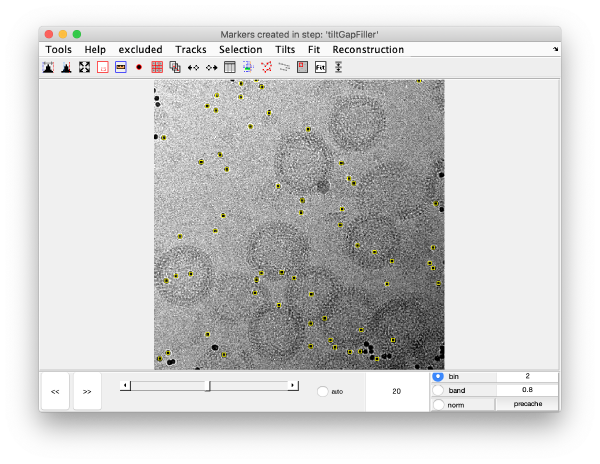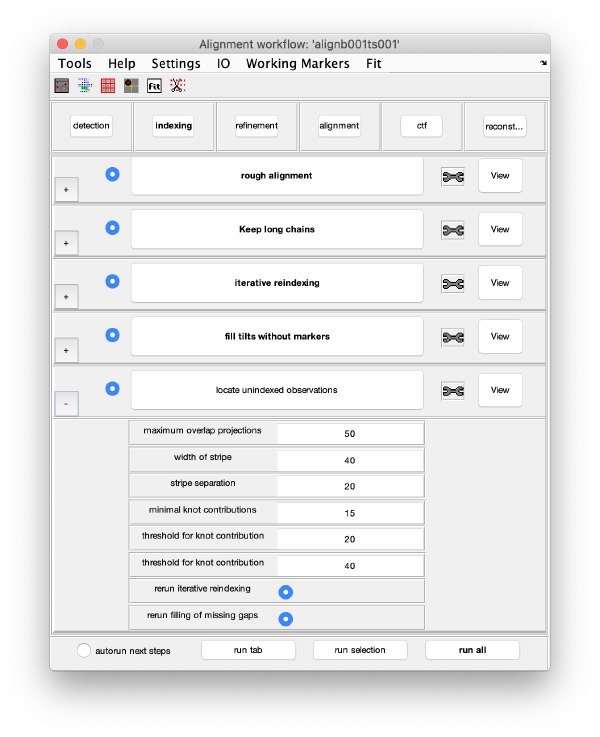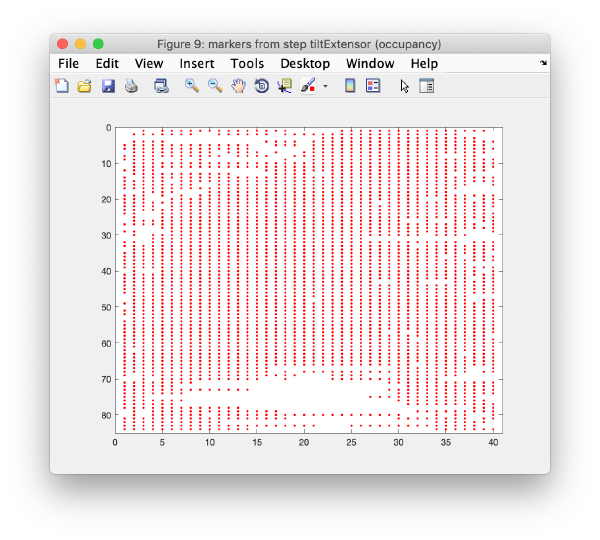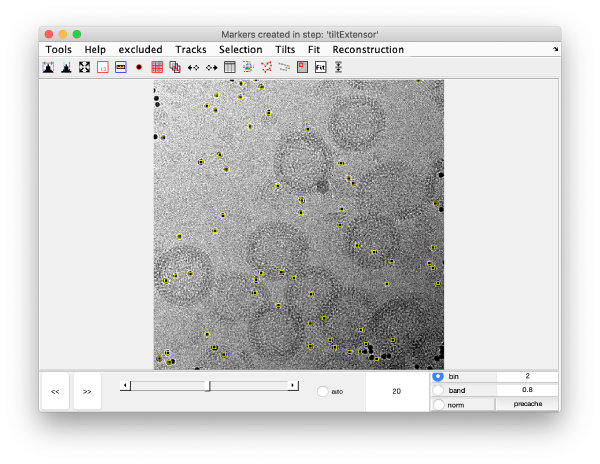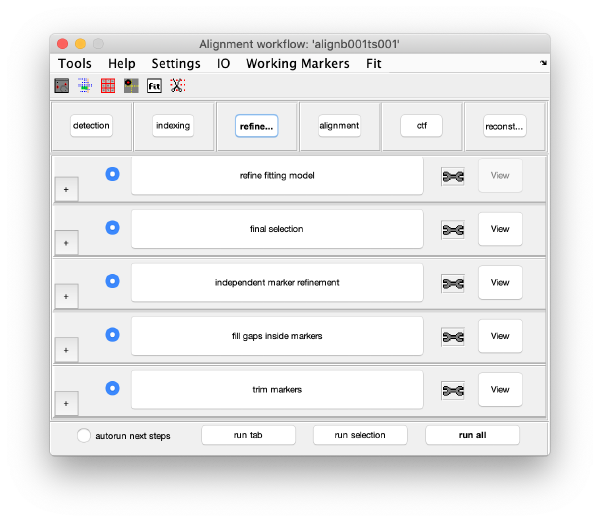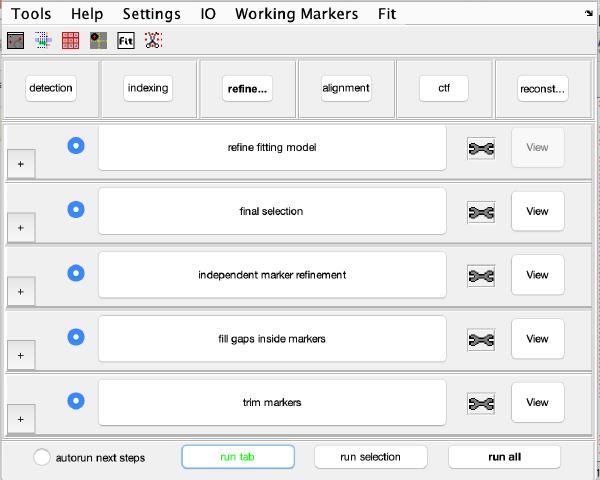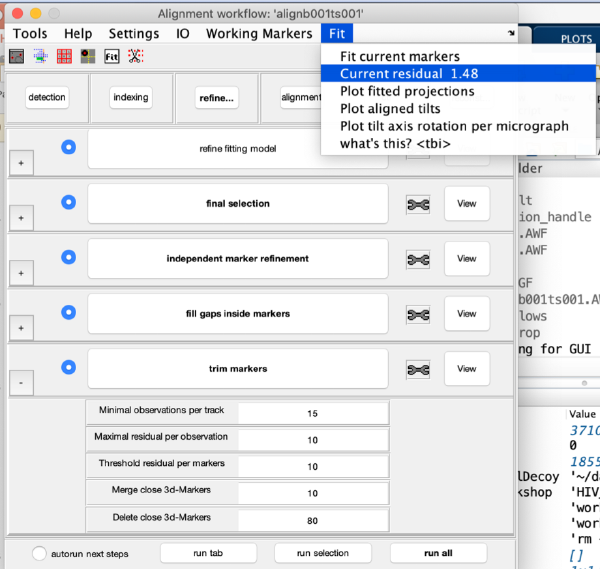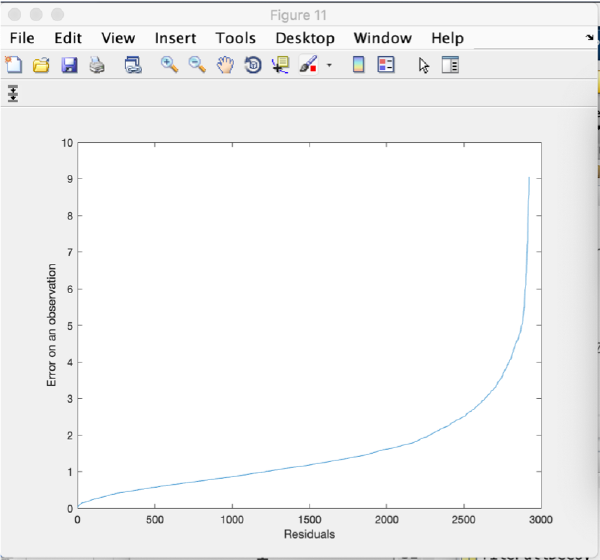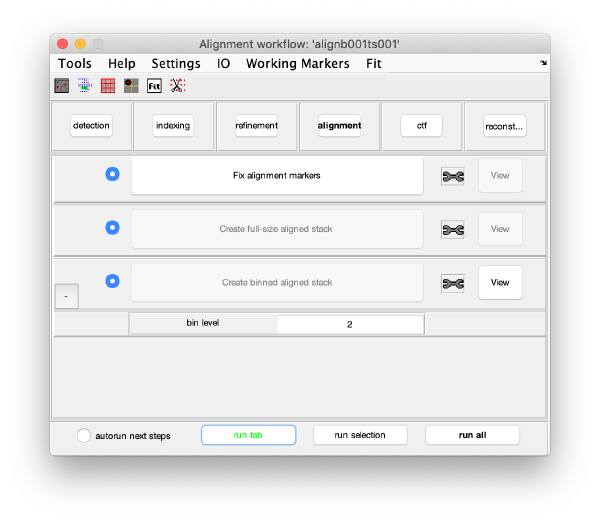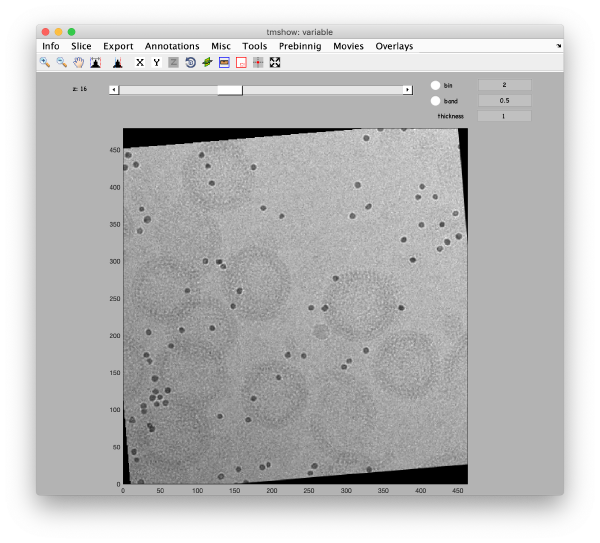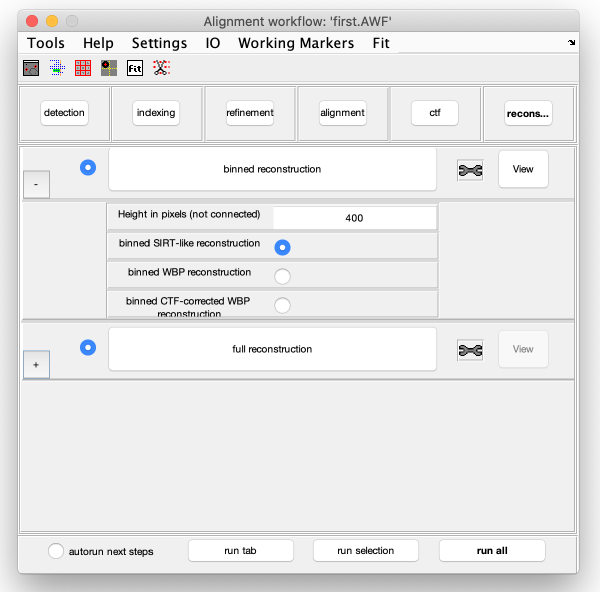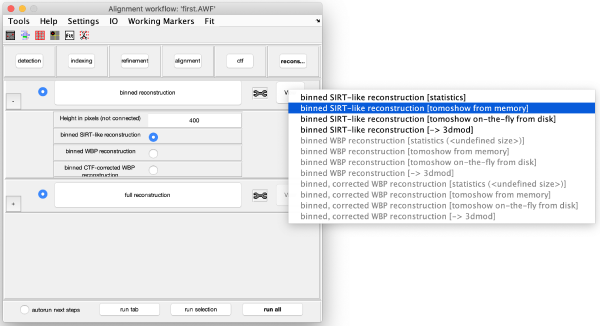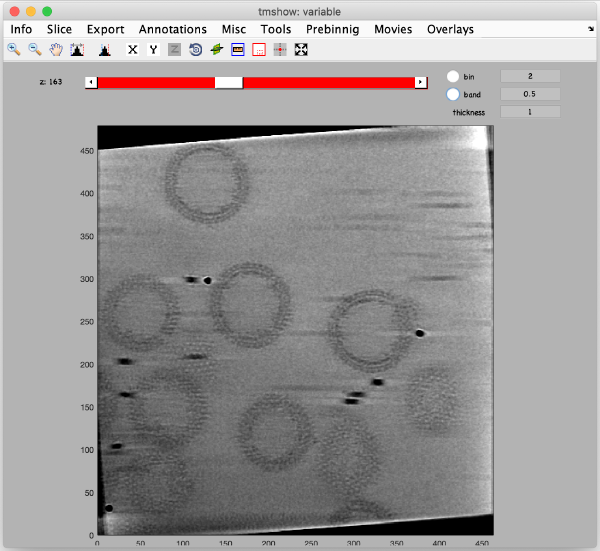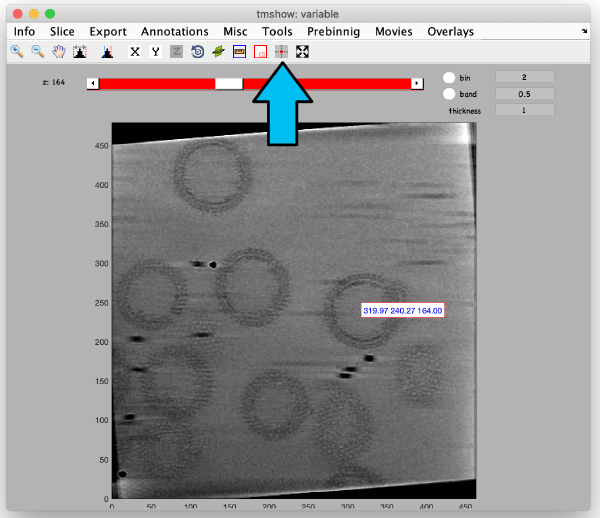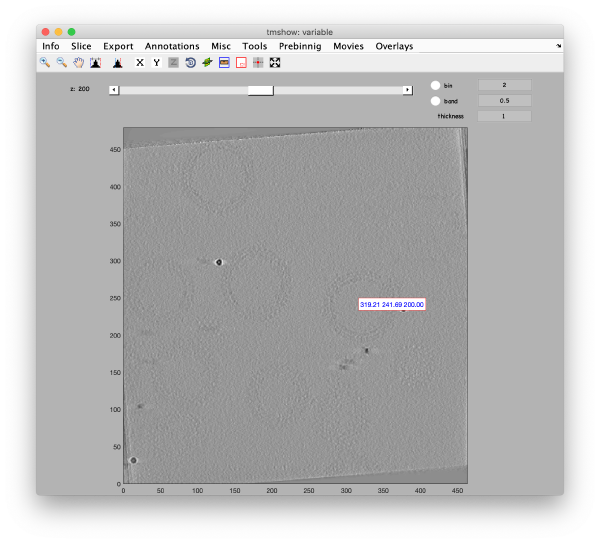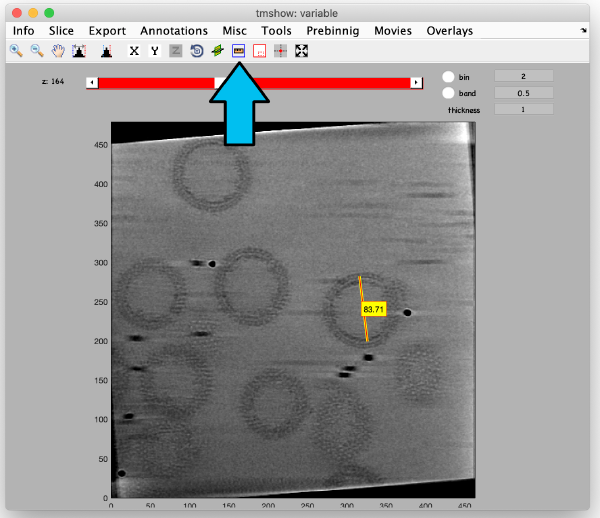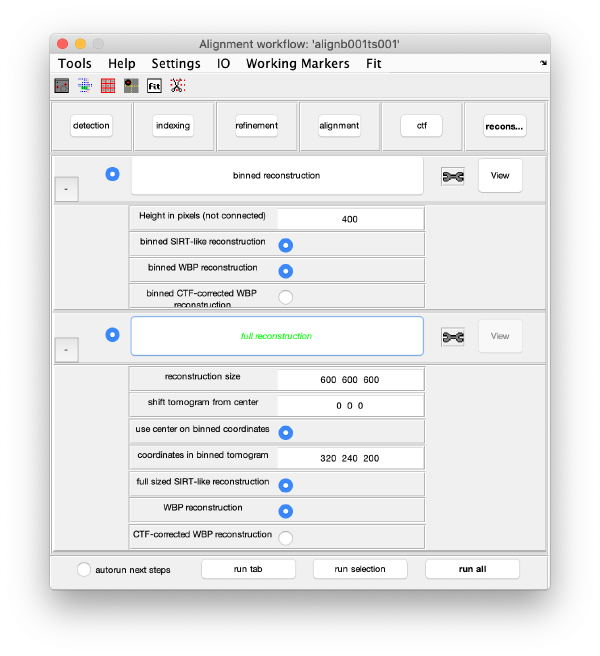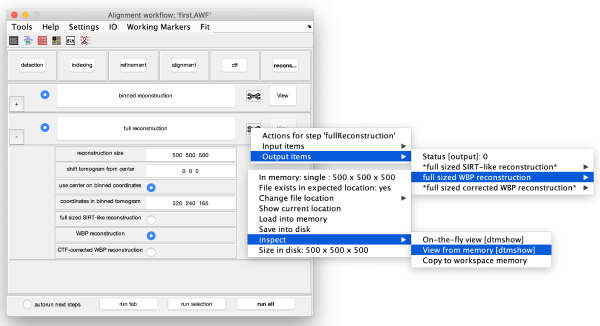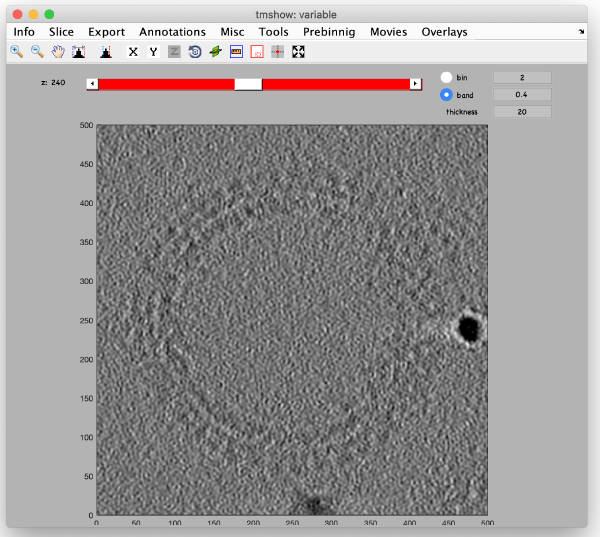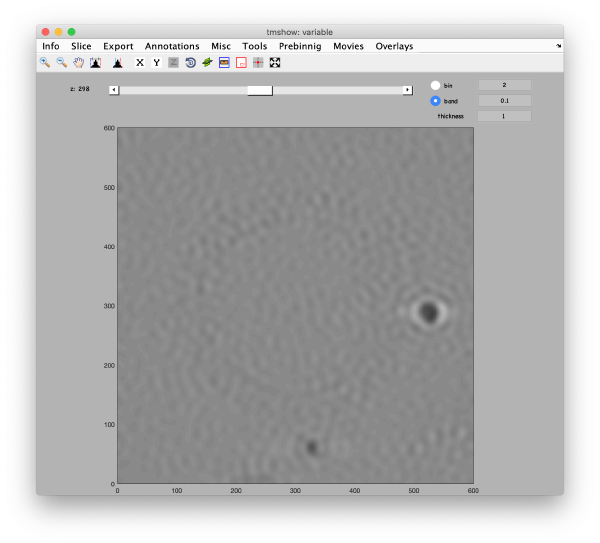Difference between revisions of "Walkthrough on GUI based tilt series alignment"
| Line 117: | Line 117: | ||
At this stage, the observed cross correlation peaks are analysed. A merit figure is assigned to each peak based on a ''rotational merit'' that measures its rotational symmetry. Press the button ''Peak features'' to compute the rotational symmetry of the current working markers. The working markers that do not meet rotational symmetry will be discarded. The results can be depicted on patches representing individual gold beads: | At this stage, the observed cross correlation peaks are analysed. A merit figure is assigned to each peak based on a ''rotational merit'' that measures its rotational symmetry. Press the button ''Peak features'' to compute the rotational symmetry of the current working markers. The working markers that do not meet rotational symmetry will be discarded. The results can be depicted on patches representing individual gold beads: | ||
[[ File:alignGUI_patchGalleryForFeatures.png |thumb|center| 600px|patch gallery for features]] | [[ File:alignGUI_patchGalleryForFeatures.png |thumb|center| 600px|patch gallery for features]] | ||
| − | [[ File:alignGUI_theGalleryAllowsRelatingAppearanceOfGoldBeadAnValueOfTheFeatures.png |thumb|center| 600px|the gallery shows the detected gold beads, the CC score (yellow) and the rotational merit (purple | + | [[ File:alignGUI_theGalleryAllowsRelatingAppearanceOfGoldBeadAnValueOfTheFeatures.png |thumb|center| 600px|the gallery shows the detected gold beads, the CC score (yellow) and the rotational merit (red). Tilt number is purple.]] |
or extracting properties of the whole data set. | or extracting properties of the whole data set. | ||
[[ File:alignGUI_featurePlotterAllowsCheckingOfTheFeatureValuesOnTheWholeSet.png |thumb|center| 600px|feature plotter allows checking of the feature values on the whole set]] | [[ File:alignGUI_featurePlotterAllowsCheckingOfTheFeatureValuesOnTheWholeSet.png |thumb|center| 600px|feature plotter allows checking of the feature values on the whole set]] | ||
| Line 124: | Line 124: | ||
=== Selection of best gold beads=== | === Selection of best gold beads=== | ||
| − | The | + | The population with the best markers is automatically selected by clicking on ''Peak selection''. The results can be inspected again in a plot |
[[ File:alignGUI_checkObservationCloudAfterSelectionOrClustering.png |thumb|center| 600px|check observation cloud after selection or clustering ]] | [[ File:alignGUI_checkObservationCloudAfterSelectionOrClustering.png |thumb|center| 600px|check observation cloud after selection or clustering ]] | ||
| − | |||
[[ File:alignGUI_observationCloudHasBeenThinned.png |thumb|center| 600px|observation cloud has been thinned]] | [[ File:alignGUI_observationCloudHasBeenThinned.png |thumb|center| 600px|observation cloud has been thinned]] | ||
| − | + | or in the micrographs themselves: | |
[[ File:alignGUI_checkMarkerPositionsAfterClustering.png |thumb|center| 600px|check marker positions after clustering]] | [[ File:alignGUI_checkMarkerPositionsAfterClustering.png |thumb|center| 600px|check marker positions after clustering]] | ||
[[ File:alignGUI_markerPositionsAfterClustering.png |thumb|center| 600px|marker positions after clustering]] | [[ File:alignGUI_markerPositionsAfterClustering.png |thumb|center| 600px|marker positions after clustering]] | ||
== Indexing == | == Indexing == | ||
| − | |||
The goal of this execution area is to find ''trails'' of gold beads, i.e., observations in different micrographs that correspond to the same 3D gold bead. All the steps in this area will update a set of ''working markers''. | The goal of this execution area is to find ''trails'' of gold beads, i.e., observations in different micrographs that correspond to the same 3D gold bead. All the steps in this area will update a set of ''working markers''. | ||
Revision as of 12:05, 3 August 2021
Dynamo includes a package for automated alignment and reconstruction of tilt series. This walkthrough guides users through a series of steps on how to use it in GUI-based mode. A different page in this wiki shows how to operate this procedure through the command line.
Contents
Data
We prepared the first tilt series from the EMPIAR entry 10164, depicting a set of virus like particles (VLP). Move to the directory that contains this data using the command:
cd prac-5
Double-check by typing
ls
to see all files in the directory. One file should be the following tilt series:
b001ts001.mrc
This is a binned version (for quicker processing) with the pixel size is 2.7 Angstrom (original deposition is 1.35).
Creating an alignment workflow
Start the alignment GUI with the function dtsa (short form of dynamo_tilt_series_alignment):
u = dtsa();
Here, u is an object that resides in memory during the session and allows to interoperate with the workflow through the command line. It is not necessary when proceeding through the GUI. After running the command above, a pop-up window appears. Click on "create a new workflow".
The input data for the workflow (tilt series, angles, ...) could be introduced directly when creating the workflow. Here, however, we introduce each item manually:
Discarded tilt angles
The option configuration file is used to pass information on possible tilts that should be discarded. Here, we leave this option untouched. If you decide to discard tilts at a later stage, you can do so while you inspecting the images in the dmarkers GUI and using the x and shift + x buttons.
GUI description
The GUI guides the process of creating a set of working markers in the tabs detection, indexing and refinement. These markers are then used to create the aligned tilt series in the alignment tab. There is further the option to estimate and correct the CTF (using wrappers of ctfffind4 and imod) and to finally create the 3D reconstructions of the tomographic data.
Alignment GUI Controls
The GUI has different pre-defined areas. Starting from top to bottom, you can find a toolbox with the options: Tools, Help, Settings, IO, Working Markers and Fit. These tools contain different visualization methods and also let you customize general settings. The option Settings > edit[general] for example lets you adjust again the pixel size and different acquisition parameters such as Cs etc. Here we use the default settings.
Under the toolbox, we find several icons: dmarkers, occupancy plot, gold bead gallery, gold bead targeting, fitting and marker selection. The most important functionalities are explained in the following:
- dmarkers: this icon opens a GUI that displays the tilt series data and the current working markers. It allows you to check the position of the working markers in each micrograph. If you want to make editions of the GUI permanent, you need to save the current markers as explained later.
- Occupancy plot: shows a scheme of which markers are present in which tilt numbers.
- Gold bead gallery: it crops the 2D patches which are currently contained in the working markers, and therefore treated as gold beads, and displays them in gallery mode.
Execution Areas
In the GUI, right below the icons, we can find six execution areas: detection, indexing, refinement, alignment, ctf, reconstruction. Each of them comprises a set of steps that can be executed sequentially. Sequential execution is the natural way of proceeding; but steps can be visited in any order, i.e., a step can be re-executed in a later moment after updating its information.
Steps
Each execution area has one or more steps. Steps need to be open (letters highlighted in black, not grey) to be executed. They become open when the required input(s) is ready to be processed. The required input(s) can be provided by users or computed and stored in a previous step of this alignment workflow. When a step is under execution, its pushbutton becomes green. Input parameters are edited by clicking the plus button on the left.
At the right side of each of the steps, a tool icon is located. The tool icon can be right-clicked to provide a pop-up menu with specific tools for each step. There are also some common tools for all the steps which handle the inspection and listing of input and output items generated by the step.
Next to the tool icon, there is a View pushbutton. The View pushbutton provides specific tools to visualize and inspect the results of each step.
Detection
The goal of this step is to find the positions of the gold bead projections in the tilt series. To do that, Dynamo cross correlates each micrograph against a 2D model of the gold bead and then locate the cross correlation peaks, which provide putative positions for actual projections of gold beads. Further analysis of these peaks will determine which ones correspond to actual gold bead projection (peak feature and peak selection).
Visualization matrix
This step just creates a binned version of the tilt series stack to accelerate visualizations that will be invoked in a later point. If you click on the box standing on the left of creates a binned tilt series button with a + symbol, an option box appears, indicating the default binning factor which is 2. This parameter can be changed by users. Binning factor 2 in Dynamo is equivalent to a binning factor of 4 in IMOD. Click on creates a binned tilt series button to create a binned tilt series stack. Rightclick on View button to visualize the newly binned tilt series stack in tmshow. In the tmshow window, visualization parameters as binning, band and thickness can be adjusted if needed.
Now, we are going to measure the diameter of the gold beads precisely in tmshow in the original (unbinned) tilt series data. To do that, press the IO in the upper toolbox of the alignment workflow GUI, then go to tilt series matrix > inspect > On-the-fly view [dtmshow]. The tmshow window opens, adjust contrast if necessary for better visualization.
Zoom in a gold bead by holding the shift key and scrolling up your mouse wheel. Adjust the visualized region by holding the shift key again and dragging with right mouse click on tmshow window.
Once you have located the gold bead of interest, click on the ruler icon at the top toolbox to activate length measurements on the displayed image data. Draw a line across the gold bead, and the length of the line appears in pixels, which correspond to the gold bead diameter. In this case, the length of this line should be 32 pixel aprox.
Detection of gold beads
This area needs to be provided with the size of the gold bead. Now, we know that the diameter of the gold bead is 32 pixels in the original image, therefore its radius is 16 pixels. We introduce the bead radius and some other parameters to create an accurate initial gold bead template. The parameters are:
- bin factor during detection = 1 (this value is just used internally for quick and robust bead detection).
- bead radius = 16
- mask radius = 28
- template side length = 64
After pressing the button detect peaks, Dynamo creates a raw cross-correlation matrix based on the initial template which is binary and extracts 300 cc-peaks by default. Then, the extracted peaks are averaged to create a refined template. The refined template is used to compute a refined cc-matrix from which 300 peaks are extracted and used as initial working markers. Once the detect peaks button turns black bold, the computation is finished. Right click on the view area of the step to access the different visualisation options.
This view shows the overlaid sum of the x,y coordinates of all cc peaks from all micrographs in the tilt series.
We can also check the positions of all the detected spots on each micrograph:
This GUI does not allow for edition of the markers. Tip: enable auto option at the bottom center of the visualization GUI to facilitate tilt series visualization.
The neighbourhood of cross correlation peaks can be visualised individually as 2D patches from the tilt series image data:
This visualization is normally a good gauge on how the detection procedure has worked. The example below would be an example of detection procedure carried with wrong search parameters
Note that you have the option of testing your parameters against a single image before launching a full detection procedure. Click on the tool icon on the right side of detect peaks pushbutton.
Computation of observation features
At this stage, the observed cross correlation peaks are analysed. A merit figure is assigned to each peak based on a rotational merit that measures its rotational symmetry. Press the button Peak features to compute the rotational symmetry of the current working markers. The working markers that do not meet rotational symmetry will be discarded. The results can be depicted on patches representing individual gold beads:
or extracting properties of the whole data set.
Selection of best gold beads
The population with the best markers is automatically selected by clicking on Peak selection. The results can be inspected again in a plot
or in the micrographs themselves:
Indexing
The goal of this execution area is to find trails of gold beads, i.e., observations in different micrographs that correspond to the same 3D gold bead. All the steps in this area will update a set of working markers.
Rough Alignment
In this step, micrographs are compared pair-wise. For each couple, we look for the relative shifts that generates the most matches of cross-correlation peaks between one micrograph and the next one. This procedure induces trails of matched pairs of observations of variable length along the tilt series. The scheme that depicts which trails have representatives in which tilts is called occupancy graph
Note that these trails are very lacunary and don't conserve the identity of a trail; whenever a trail that represents an actual 3d marker gets interrupted, the same 3d marker might generate a different trail in other tilts.
Selection of stable trails
We select the longest trails, which will then be used to generate a 3d model of the markers:
Note that from this step onwards, the toolbox of each step offers the possibility to revert the current markers to the output generated at that state. Thus, if further processing of the markers in a later step leads you to loose a good marker set, you can always come back to this point.
Iterative reindexing
The 3d model is projected on each micrograph. Observations that are closest (and below a distance threshold) to each reprojection are assigned to the corresponding 3d marker. This refines the 3d model, and the process is iterated till no further improvement occurs (or till a maximum of ten iterations is reached).
Tilt gap filling
Dynamo can be directed to try to analyse those tilts that wind up not having any marker (and that have not been explicitly rejected by the user). The cloud of observations found on that micrograph will be compared to the cloud or reproductions generated by the current model.
Trail extension
This step aims at locating trails that have been excluded by previous steps of the alignment procedure, or that were never detected as trails because previous, lesser quality stages of the 3d model were not able to analyse the observations correctly.
Note that newly added trails have empty spaces in the central area, they are likely to be gold beads located far away from the tilt axes and which get into the field of view only for high tilts.
Refinement
This area refines the positions of the gold beads. We will run all steps of this area pressing on a single button (the run this tab option at the bottom of the GUI)
The Botton remains green while the succession of different steps gets computed.
We can use the scissors icon in order to "trim" observations (or full markers) with too high residuals
Alignment
This area creates the aligned tilt series. It creates two version, a binned one and one with full resolution pixel size. Note that the binning level of this one is independent of the binning level used in the detection step.
Fix the markers
Here we just freeze the working markers and create a marker file that will define all subsequent steps of alignment and reconstruction.
Align the tilt series
We then proceed to the alignment task itself, generating the binned and the full resolution stacks.
CTF
In this GUI CTF estimation and correction are delegated to CTFFIND4 and Imod's ctfphaseflip programs respectively. This part will not be used in the workshop.'
Reconstruction
Binned reconstruction
This version of Dynamo fixes the tomogram center at the 3d reconstruction center of the aligned stack.
Full sized reconstruction
The full sized reconstruction can be created related to a coordinate directly read in the binned tomogram, a feature useful for creating reconstructions localised on an area of interest. In this case, we will focus on one of the VLPS.
Use the pin tool to select a point on the binned reconstruction.
We also check the size of a structure of interest. We measure it in the binned tomogram.
A viewer system is not yet connected to this step, we can however use the common inspection tools to fetch the outcome (the full sized WBP)
As it is a full resolution reconstruction, it is much noisier than the corresponding area in the binned tomogram. You probably need to use a rather deep bandpass (around 0.2 of nyquist) in order to distinguish it.
]

